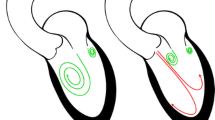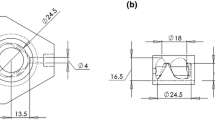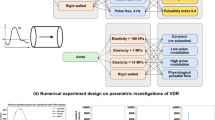Abstract
This study aims to quantitatively and qualitatively assess energy dissipation in the aortic valve as a function of systolic aortic flow waveform representing pathologies where flow time-to-peak is delayed. A bioprosthetic valve was tested in the aortic position of a left-heart simulator under physiological pressure and flow conditions. The flow loop piston pump was programmed to generate three different flow waveforms each with a different peak time annotated as early peak (EP) with a rapid acceleration, mid peak (MP) and late peak (LP) with a rapid deceleration. Energy dissipation was calculated from flow and pressure measurements while sinus vorticity dynamics were evaluated using time-resolved planar particle image velocimetry. Average pressure gradients during systole are found 30.2 ± 0.19, 30.7 ± 0.25 and 32.9 ± 0.29 mmHg and average dissipation over systole is found 0.95 ± 0.026, 1.05 ± 0.034 and 1.25 ± 0.043 W for EP, MP and LP respectively. As systole’s acceleration phase is slower, sinus vortices are more likely to form, necessitating more energy exchange from shear layers inducing more viscous dissipation. EP found in healthy individuals is superior in terms of reducing energy dissipation and increasing aortic valve efficiency. In the context of possible left ventricular dysfunction and aortic stenosis, this means that delayed time-to-peak in the aortic flow waveform seen is not compensatory.






Similar content being viewed by others
References
Dasi, L. P., L. Ge, H. A. Simon, F. Sotiropoulos, and A. P. Yoganathan. Vorticity dynamics of a bileaflet mechanical heart valve in an axisymmetric aorta. Phys. Fluids 19:067105, 2007.
Dasi, L. P., H. Hatoum, A. Kheradvar, R. Zareian, S. H. Alavi, W. Sun, C. Martin, T. Pham, Q. Wang, and P. A. Midha. On the mechanics of transcatheter aortic valve replacement. Ann. Biomed. Eng. 45:310–331, 2017.
Fukuta, H., and W. C. Little. The cardiac cycle and the physiologic basis of left ventricular contraction, ejection, relaxation, and filling. Heart Fail. Clin. 4:1–11, 2008.
Gao, L., and S. C. M. Yu. Development of the trailing shear layer in a starting jet during pinch-off. J. Fluid Mech. 700:382–405, 2012.
Gharib, M., E. Rambod, and K. Shariff. A universal time scale for vortex ring formation. J. Fluid Mech. 360:121–140, 1998.
Hatoum, H., J. Dollery, S. M. Lilly, J. A. Crestanello, and L. P. Dasi. Effect of severe bioprosthetic valve tissue ingrowth and inflow calcification on valve-in-valve performance. J. Biomech. 74:171–179, 2018.
Hatoum, H., J. Dollery, S. M. Lilly, J. A. Crestanello, and L. P. Dasi. Implantation depth and rotational orientation effect on valve-in-valve hemodynamics and sinus flow. Ann. Thorac. Surg. 2018. https://doi.org/10.1016/j.athoracsur.2018.01.070.
Hatoum, H., J. Dollery, S. M. Lilly, J. Crestanello, and L. P. Dasi. Impact of patient morphologies on sinus flow stasis in transcatheter aortic valve replacement: an in-vitro study. J. Thorac. Cardiovasc. Surg. 2018. https://doi.org/10.1016/j.jtcvs.2018.05.086.
Hatoum, H., F. Heim, and L. P. Dasi. Stented valve dynamic behavior induced by polyester fiber leaflet material in transcatheter aortic valve devices. J. Mech. Behav. Biomed. Mater. 86:232–239, 2018.
Hatoum, H., B. L. Moore, P. Maureira, J. Dollery, J. A. Crestanello, and L. P. Dasi. Aortic sinus flow stasis likely in valve-in-valve transcatheter aortic valve implantation. J. Thorac. Cardiovasc. Surg. 54(1):32–43, 2017.
Hatoum, H., A. Yousefi, S. Lilly, P. Maureira, J. Crestanello, and L. P. Dasi. An in-vitro evaluation of turbulence after transcatheter aortic valve implantation. J. Thorac. Cardiovasc. Surg. 2018. https://doi.org/10.1016/j.jtcvs.2018.05.042.
Ho, S., H. Banerjee, Y. Y. Foo, H. Godaba, W. M. M. Aye, J. Zhu, and C. H. Yap. Experimental characterization of a dielectric elastomer fluid pump and optimizing performance via composite materials. J. Intell. Mater. Syst. Struct. 28:3054–3065, 2017.
Kamimura, D., S. Hans, T. Suzuki, E. R. Fox, M. E. Hall, S. K. Musani, M. R. McMullan, and W. C. Little. Delayed time to peak velocity is useful for detecting severe aortic stenosis. J. Am. Heart Assoc. 5:e003907, 2016.
Kanski, M., P. M. Arvidsson, J. Töger, R. Borgquist, E. Heiberg, M. Carlsson, and H. Arheden. Left ventricular fluid kinetic energy time curves in heart failure from cardiovascular magnetic resonance 4d flow data. J. Cardiovasc. Magn. Reson. 17:111, 2015.
Li, Z., Y. Wang, C. C. Foo, H. Godaba, J. Zhu, and C. H. Yap. The mechanism for large-volume fluid pumping via reversible snap-through of dielectric elastomer. J. Appl. Phys. 122:084503, 2017.
Li, Z., J. Zhu, C. C. Foo, and C. H. Yap. A robust dual-membrane dielectric elastomer actuator for large volume fluid pumping via snap-through. Appl. Phys. Lett. 111:212901, 2017.
Maxworthy, T. The structure and stability of vortex rings. J. Fluid Mech. 51:15–32, 1972.
Mohseni, K., and M. Gharib. A model for universal time scale of vortex ring formation. Phys. Fluids 10:2436–2438, 1998.
Mohseni, K., H. Ran, and T. Colonius. Numerical experiments on vortex ring formation. J. Fluid Mech. 430:267–282, 2001.
Moore, B. L., and L. P. Dasi. Coronary flow impacts aortic leaflet mechanics and aortic sinus hemodynamics. Ann. Biomed. Eng. 43:2231–2241, 2015.
Okafor, I. U., A. Santhanakrishnan, V. S. Raghav, and A. P. Yoganathan. Role of mitral annulus diastolic geometry on intraventricular filling dynamics. J. Biomech. Eng. 137:121007, 2015.
Reul, H, and Talukder, N, Heart valve mechanics. In: Quantitative Cardiovascular Studies Clinical and Research Applications of Engineering Principles, 1979, pp. 527–564.
Reynolds, O. On the resistance encountered by vortex rings, and the relation between the vortex rings and streamlines of a disk. Nature 14:477–479, 1876.
Vasudevan, V., A. J. J. Low, S. P. Annamalai, S. Sampath, K. K. Poh, T. Totman, M. Mazlan, G. Croft, A. M. Richards, and D. P. V. de Kleijn. Flow dynamics and energy efficiency of flow in the left ventricle during myocardial infarction. Biomech. Model. Mechanobiol. 16:1503–1517, 2017.
Wang, Y., Z. Li, L. Qin, G. Caddy, C. H. Yap, and J. Zhu. Dielectric elastomer fluid pump of high pressure and large volume via synergistic snap-through. J. Appl. Mech. 85:101003, 2018.
Yap, C.-H., L. P. Dasi, and A. P. Yoganathan. Dynamic hemodynamic energy loss in normal and stenosed aortic valves. J. Biomech. Eng. 132:021005, 2010.
Yoganathan, A. P., Z. He, and S. Casey Jones. Fluid mechanics of heart valves. Annu. Rev. Biomed. Eng. 6:331–362, 2004.
Acknowledgments
The research done was partly supported by National Institutes of Health (NIH) under Award Number R01HL119824.
Conflict of interest
Dr. Dasi reports having a patent application filed on novel polymeric valves, vortex generator and super-hydrophobic valve designs. No other conflicts were reported.
Author information
Authors and Affiliations
Corresponding author
Additional information
Associate Editor Jane Grande-Allen oversaw the review of this article.
Electronic supplementary material
Below is the link to the electronic supplementary material.
10439_2018_2102_MOESM1_ESM.mp4
Video 1: Main sinus flow streak visualization for Early Peak, Mid Peak and Late Peak cases. Supplementary material 1 (MP4 4760 kb)
Rights and permissions
About this article
Cite this article
Hatoum, H., Moore, B.L. & Dasi, L.P. On the Significance of Systolic Flow Waveform on Aortic Valve Energy Loss. Ann Biomed Eng 46, 2102–2111 (2018). https://doi.org/10.1007/s10439-018-2102-y
Received:
Accepted:
Published:
Issue Date:
DOI: https://doi.org/10.1007/s10439-018-2102-y




